What makes a good book?#

A DataCamp challenge Feb, 2025
Classification
The project#
Build a model that accurately predicts book popularity, which will help a bookstore manage their stock better and tweak their marketing plans to suit what their readers love the most.
The data#
Column |
Description |
|---|---|
|
Book title. |
|
Book price. |
|
The number of helpful reviews over the total number of reviews. |
|
The summary of the review. |
|
The review’s full text. |
|
The book’s description. |
|
Author. |
|
Book categories. |
|
Whether the book was popular or unpopular. |
Data validation#
Read the data#
Show code cell source
# Import packages
import matplotlib.pyplot as plt
import nltk
import numpy as np
import pandas as pd
import seaborn as sns
from category_encoders import TargetEncoder
from nltk import word_tokenize
from nltk.sentiment.vader import SentimentIntensityAnalyzer
from sklearn.linear_model import LogisticRegression
from sklearn.metrics import accuracy_score, classification_report
from sklearn.model_selection import train_test_split
from sklearn.preprocessing import StandardScaler
# Read the data
books = pd.read_csv("data/books.csv")
books
| title | price | review/helpfulness | review/summary | review/text | description | authors | categories | popularity | |
|---|---|---|---|---|---|---|---|---|---|
| 0 | We Band of Angels: The Untold Story of America... | 10.88 | 2/3 | A Great Book about women in WWII | I have alway been a fan of fiction books set i... | In the fall of 1941, the Philippines was a gar... | 'Elizabeth Norman' | 'History' | Unpopular |
| 1 | Prayer That Brings Revival: Interceding for Go... | 9.35 | 0/0 | Very helpful book for church prayer groups and... | Very helpful book to give you a better prayer ... | In Prayer That Brings Revival, best-selling au... | 'Yong-gi Cho' | 'Religion' | Unpopular |
| 2 | The Mystical Journey from Jesus to Christ | 24.95 | 17/19 | Universal Spiritual Awakening Guide With Some ... | The message of this book is to find yourself a... | THE MYSTICAL JOURNEY FROM JESUS TO CHRIST Disc... | 'Muata Ashby' | 'Body, Mind & Spirit' | Unpopular |
| 3 | Death Row | 7.99 | 0/1 | Ben Kincaid tries to stop an execution. | The hero of William Bernhardt's Ben Kincaid no... | Upon receiving his execution date, one of the ... | 'Lynden Harris' | 'Social Science' | Unpopular |
| 4 | Sound and Form in Modern Poetry: Second Editio... | 32.50 | 18/20 | good introduction to modern prosody | There's a lot in this book which the reader wi... | An updated and expanded version of a classic a... | 'Harvey Seymour Gross', 'Robert McDowell' | 'Poetry' | Unpopular |
| ... | ... | ... | ... | ... | ... | ... | ... | ... | ... |
| 15714 | Attack of the Deranged Mutant Killer Monster S... | 7.64 | 0/0 | Great for Calvin lovers | Bought as a Christmas gift, great book for kin... | Online: gocomics.com/calvinandhobbes/ | 'Bill Watterson' | 'Comics & Graphic Novels' | Unpopular |
| 15715 | Book Savvy | 33.99 | 2/2 | literary pleasure | I thoroughly enjoyed Ms. Katona's Book Savvy. ... | Recounts the adventures of Mibs Beaumont, whos... | 'Ingrid Law' | 'Juvenile Fiction' | Popular |
| 15716 | Organizing to Win: New Research on Union Strat... | 24.95 | 3/4 | Great Book for Union Organizers! | This is a good reference tool for Union Organi... | As the American labour movement mobilizes for ... | 'Kate Bronfenbrenner', 'Sheldon Friedman', 'Ri... | 'Business & Economics' | Popular |
| 15717 | The Dharma Bums | 39.95 | 3/3 | The Sad, Beautiful, Joyful World of Jack Kerouac | Jack Kerouac was intensely alive and his fiery... | THE DHARMA BUMS appeared just one year after t... | 'Jack Kerouac' | 'Fiction' | Popular |
| 15718 | Palomino | 7.99 | 0/0 | "Palomino" | This is an older novel of Danielle Steele's, a... | Samantha Taylor is shattered when her husband ... | 'Danielle Steel' | 'Fiction' | Popular |
15719 rows × 9 columns
Check data quality#
Missing values#
Show code cell source
# Get df info
books.info()
<class 'pandas.core.frame.DataFrame'>
RangeIndex: 15719 entries, 0 to 15718
Data columns (total 9 columns):
# Column Non-Null Count Dtype
--- ------ -------------- -----
0 title 15719 non-null object
1 price 15719 non-null float64
2 review/helpfulness 15719 non-null object
3 review/summary 15718 non-null object
4 review/text 15719 non-null object
5 description 15719 non-null object
6 authors 15719 non-null object
7 categories 15719 non-null object
8 popularity 15719 non-null object
dtypes: float64(1), object(8)
memory usage: 1.1+ MB
There is only one missing values, I will drop that row.
Show code cell source
# Drop missing values
books.dropna(inplace=True)
Duplicated values#
Show code cell source
# Check on all columns
print(f"Duplicated rows -> {books.duplicated().sum()}")
Duplicated rows -> 3294
I will drop all duplicated records.
Show code cell source
# Drop duplicated rows
books.drop_duplicates(inplace=True)
Check value ranges#
Categorical data#
Let’s see value ranges in categorical data columns authors and categories, and the balance of the target variable popularity.
Show code cell source
# Print number of unique values
print(f"Number of unique 'authors' -> {books["authors"].nunique()}")
print(f"Number of unique 'categories' -> {books["categories"].nunique()}")
Number of unique 'authors' -> 6447
Number of unique 'categories' -> 313
We can see that these categorical columns, especially “authors”, have lots of unique values (“high cardinality”).
Show code cell source
# Plot the counting of top authors
n_top = 25
fig, ax = plt.subplots(figsize=(5, 3))
books["authors"].value_counts()[:n_top].plot(ax=ax, kind="bar")
ax.set_title(f"Top {n_top} authors", fontsize=11)
ax.set_ylabel("Counts")
sns.despine()
plt.show()
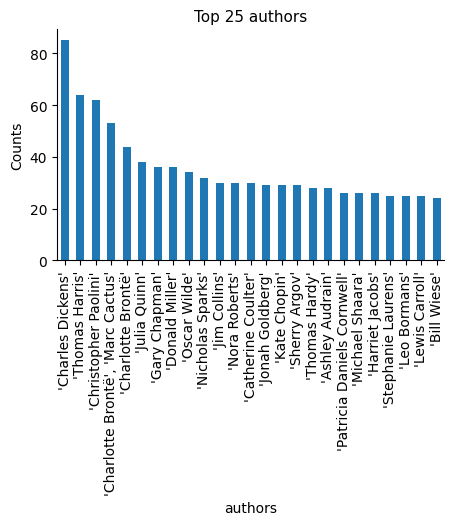
We also observe that some authors consist of more than one name, separated by a comma, as seen in the case of ‘Charlotte Brontë, Marc Cactus’ in the 4th position, and also ‘Charlotte Brontë’ in the 5th position.
Show code cell source
# Plot the counting of top authors
n_top = 25
fig, ax = plt.subplots(figsize=(5, 3))
books["categories"].value_counts()[:n_top].plot(ax=ax, kind="bar")
ax.set_title(f"Top {n_top} categories", fontsize=11)
ax.set_ylabel("Counts")
sns.despine()
plt.show()
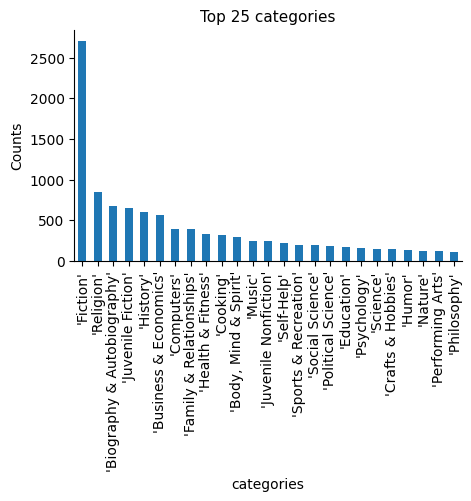
Show code cell source
# Plot popularity counts
fig, ax = plt.subplots(figsize=(4, 3))
books["popularity"].value_counts().plot(ax=ax, kind="bar")
ax.tick_params(axis="x", labelsize=10, rotation=0)
ax.set_ylabel("Counts")
sns.despine()
plt.show()
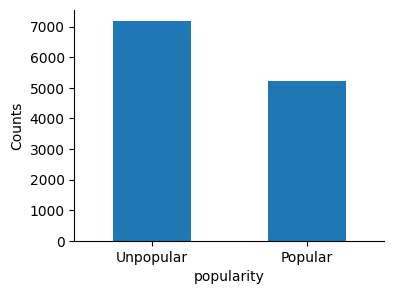
Numerical data#
Show code cell source
# Plot prices' histogram
fig, ax = plt.subplots(figsize=(5, 3))
books["price"].plot(ax=ax, kind="hist")
ax.set_xlabel("Price")
sns.despine()
plt.show()
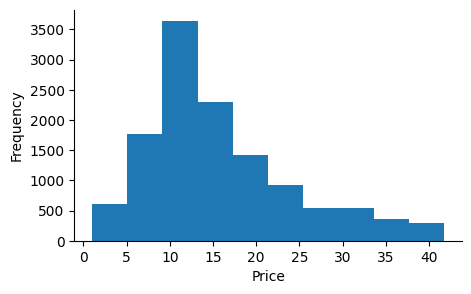
Data preprocessing#
Split “review/helpfulness”#
“review/helpfulness” column can be split into two different columns: “helpful_reviews” and “total_reviews”.
Show code cell source
# Split strings around "/" separator, and convert new columns to numerical integer
books[["helpful_reviews", "total_reviews"]] = (
books["review/helpfulness"].str.split("/", expand=True).astype("int")
)
# Show result in first rows
books[["review/helpfulness", "helpful_reviews", "total_reviews"]].head()
| review/helpfulness | helpful_reviews | total_reviews | |
|---|---|---|---|
| 0 | 2/3 | 2 | 3 |
| 1 | 0/0 | 0 | 0 |
| 2 | 17/19 | 17 | 19 |
| 3 | 0/1 | 0 | 1 |
| 4 | 18/20 | 18 | 20 |
Show code cell source
# Drop processed column
books.drop(["review/helpfulness"], axis=1, inplace=True)
Sentiment analysis in review texts#
I will apply sentiment analysis to get a polarity score (between [-1, 1], with “-1” negative, “0” neutral, “1” positive) in “review/summary” and “review/text” columns.
Show code cell source
# Download the VADER lexicon
nltk.download("vader_lexicon", quiet=True)
# Instanciate sentiment analyzer
sentiment_analyzer = SentimentIntensityAnalyzer()
# Apply to review summary and text columns creating new features
books["review_sum_sent"] = books["review/summary"].apply(
lambda text: sentiment_analyzer.polarity_scores(text)["compound"]
)
books["review_text_sent"] = books["review/text"].apply(
lambda text: sentiment_analyzer.polarity_scores(text)["compound"]
)
# Show result in first rows
books[["review/summary", "review_sum_sent", "review/text", "review_text_sent"]].head()
| review/summary | review_sum_sent | review/text | review_text_sent | |
|---|---|---|---|---|
| 0 | A Great Book about women in WWII | 0.6249 | I have alway been a fan of fiction books set i... | 0.8482 |
| 1 | Very helpful book for church prayer groups and... | 0.4754 | Very helpful book to give you a better prayer ... | 0.8955 |
| 2 | Universal Spiritual Awakening Guide With Some ... | 0.0000 | The message of this book is to find yourself a... | 0.9155 |
| 3 | Ben Kincaid tries to stop an execution. | -0.2960 | The hero of William Bernhardt's Ben Kincaid no... | -0.2582 |
| 4 | good introduction to modern prosody | 0.4404 | There's a lot in this book which the reader wi... | 0.9571 |
Is there a positive correlation between the review text score and the summary sentiment score?
Show code cell source
# Check correlation
corr = books["review_sum_sent"].corr(books["review_text_sent"])
print(f"\n{corr:.2f} <- correlation between sentiment in review summary and text")
0.26 <- correlation between sentiment in review summary and text
Scarce correlation. So I will leave it like that, without merging them in an average value.
Word tokenize review texts#
I will compute the number of words-tokens in the review texts, this value may capture the interest the book has received.
Show code cell source
# Download nltk necessary package
nltk.download("punkt_tab", quiet=True)
# Apply tokenizer to the column, creating a new one with the value
books["review_text_ntokens"] = books["review/text"].apply(
lambda text: len(word_tokenize(text))
)
# Show result in first rows
books[["review/text", "review_text_ntokens"]].head()
| review/text | review_text_ntokens | |
|---|---|---|
| 0 | I have alway been a fan of fiction books set i... | 105 |
| 1 | Very helpful book to give you a better prayer ... | 25 |
| 2 | The message of this book is to find yourself a... | 1375 |
| 3 | The hero of William Bernhardt's Ben Kincaid no... | 430 |
| 4 | There's a lot in this book which the reader wi... | 407 |
Lowercase categories#
Adjust book categories to lowercase, because some of the entries were repeated in uppercase.
Show code cell source
# Show some of the categories in uppercase
books.loc[books["categories"].str.isupper(), ["categories"]][:10]
| categories | |
|---|---|
| 576 | 'SAP R/3' |
| 1009 | 'FAMILY & RELATIONSHIPS' |
| 1009 | 'FAMILY & RELATIONSHIPS' |
| 1801 | 'COMICS & GRAPHIC NOVELS.' |
| 1812 | 'FICTION' |
| 1895 | 'LANGUAGE ARTS & DISCIPLINES' |
| 1895 | 'LANGUAGE ARTS & DISCIPLINES' |
| 1895 | 'LANGUAGE ARTS & DISCIPLINES' |
| 2119 | 'BIOGRAPHY & AUTOBIOGRAPHY' |
| 2205 | 'SAP R/3' |
Show code cell source
# Convert all categories to lowercase
books["categories"] = books["categories"].str.lower()
Convert data types#
I will replace the target variable “popularity” from “Popular” and “Unpopular” to numerical values “0” and “1”.
I will convert “authors” and “categories” to categorical data types.
I will drop unnecessary columns for the project: “title”, “description”, “review/summary”, “review/text”.
Show code cell source
# Replace target variable from category to numerical value
books["popularity"] = books["popularity"].apply(
lambda popularity: 1 if popularity == "Popular" else 0
)
# Apply conversion to categorical
books[["authors", "categories"]] = books[["authors", "categories"]].astype("category")
# Drop unnecessary columns
books.drop(
["title", "description", "review/summary", "review/text"], axis=1, inplace=True
)
# Show dataframe info
books.info()
<class 'pandas.core.frame.DataFrame'>
Index: 15275 entries, 0 to 15718
Data columns (total 9 columns):
# Column Non-Null Count Dtype
--- ------ -------------- -----
0 price 15275 non-null float64
1 authors 15275 non-null category
2 categories 15275 non-null category
3 popularity 15275 non-null int64
4 helpful_reviews 15275 non-null int32
5 total_reviews 15275 non-null int32
6 review_sum_sent 15275 non-null float64
7 review_text_sent 15275 non-null float64
8 review_text_ntokens 15275 non-null int64
dtypes: category(2), float64(3), int32(2), int64(2)
memory usage: 1.2 MB
We are now ready to test a model for classification.
Classifier#
I will define target and features:
Show code cell source
# Define target
target = books["popularity"]
# Define the features
features = books.drop("popularity", axis=1)
features.head()
| price | authors | categories | helpful_reviews | total_reviews | review_sum_sent | review_text_sent | review_text_ntokens | |
|---|---|---|---|---|---|---|---|---|
| 0 | 10.88 | 'Elizabeth Norman' | 'history' | 2 | 3 | 0.6249 | 0.8482 | 105 |
| 1 | 9.35 | 'Yong-gi Cho' | 'religion' | 0 | 0 | 0.4754 | 0.8955 | 25 |
| 2 | 24.95 | 'Muata Ashby' | 'body, mind & spirit' | 17 | 19 | 0.0000 | 0.9155 | 1375 |
| 3 | 7.99 | 'Lynden Harris' | 'social science' | 0 | 1 | -0.2960 | -0.2582 | 430 |
| 4 | 32.50 | 'Harvey Seymour Gross' | 'poetry' | 18 | 20 | 0.4404 | 0.9571 | 407 |
I will also define a function, based on a Logistic Regression model, that will be used several times later.
Show code cell source
def lg_classifier(X_train, X_test, y_train, y_test):
"""Logistic Regression classifier"""
# Scale
scaler = StandardScaler()
X_train_scaled = pd.DataFrame(scaler.fit_transform(X_train), columns=X.columns)
X_test_scaled = pd.DataFrame(scaler.transform(X_test), columns=X.columns)
# Instantiate model
model = LogisticRegression()
# Fit model to the training set
model.fit(X_train_scaled, y_train)
# Predict test set values
y_pred = model.predict(X_test_scaled)
# Print results
print(f"{accuracy_score(y_test, y_pred):.2f} <- Test-set accuracy ")
print(
f"{accuracy_score(y_train, model.predict(X_train_scaled)):.2f} <- Train-set accuracy "
)
return model, y_pred
1) One-hot encoding#
The first approach will be to one-hot encode “authors” and “categories”:
Show code cell source
# Get dummies for features
features_dummied = pd.get_dummies(features, drop_first=True, dtype="int")
features_dummied.shape
(15275, 8368)
Due to the high cardinality, it gives us a huge amount of columns. That will probably overfit the model. Let’s check it out.
Show code cell source
# Assign target a features
y = target
X = features_dummied
# Split dataset into training and test set, and stratify
X_train, X_test, y_train, y_test = train_test_split(
X, y, test_size=0.3, random_state=42, stratify=y
)
_, _ = lg_classifier(X_train, X_test, y_train, y_test)
0.63 <- Test-set accuracy
0.88 <- Train-set accuracy
Indeed, it overfits the logistic regression model.
What if we drop categories and use only numeric features?
Show code cell source
# Define features
features = books.drop(["popularity", "authors", "categories"], axis=1)
# Assign target a features
y = target
X = features
# Split dataset into training and test set, and stratify
X_train, X_test, y_train, y_test = train_test_split(
X, y, test_size=0.3, random_state=42, stratify=y
)
_, _ = lg_classifier(X_train, X_test, y_train, y_test)
0.64 <- Test-set accuracy
0.63 <- Train-set accuracy
The model here is not overfitting, confirming the previous problem of the high dimensionality.
Let’s see if we can improve these results.
2) Grouping together rare categories#
To reduce the dimensionality, let’s group rare authors and rare book categories into a new category name called “other”.
First I will consider a cutoff value to rename a rare author as “other”.
Show code cell source
# Count how many times an author appears
authors_by_freq = books["authors"].value_counts()
# Define a cutoff value to consider an author as rare
freq_cutoff_a = 5
# Create a list of rare (scarce) authors
rare_authors = [
author for author, freq in authors_by_freq.items() if freq <= freq_cutoff_a
]
# Create a new "authors" feature where rare authors are grouped into a group called "other"
books["authors_rare_grouped"] = books["authors"].apply(
lambda author: "other" if author in rare_authors else author
)
# Show results in first rows
books[["authors", "authors_rare_grouped"]].head()
| authors | authors_rare_grouped | |
|---|---|---|
| 0 | 'Elizabeth Norman' | 'Elizabeth Norman' |
| 1 | 'Yong-gi Cho' | other |
| 2 | 'Muata Ashby' | other |
| 3 | 'Lynden Harris' | other |
| 4 | 'Harvey Seymour Gross' | other |
Show code cell source
# Count unique authors
print(f"Number of unique authors -> {books["authors_rare_grouped"].nunique()}")
Number of unique authors -> 311
I will do the same with book categories:
Show code cell source
# Count how many times a category appears
categories_by_freq = books["categories"].value_counts()
# Define a cutoff value to consider a category as rare
freq_cutoff_c = 2
# Create a list of rare_categories with cutoff
rare_categories = [category for category, freq in categories_by_freq.items() if freq <= freq_cutoff_c]
# Create a new "categories" feature where rare categories are grouped into a group called "other"
books["categories_rare_grouped"] = books["categories"].apply(lambda category: "other" if category in rare_categories else category)
# Count unique categories
print(f"Number of unique categories -> {books["categories_rare_grouped"].nunique()}")
Number of unique categories -> 121
Let’s model it with one-hot encoding:
Show code cell source
# Define features
features = books.drop(["popularity", "authors", "categories"], axis=1)
# Get dummies for features
features_dummied = pd.get_dummies(features, drop_first=True, dtype="int")
# Assign target a features
y = target
X = features_dummied
# Split dataset into training and test set, and stratify
X_train, X_test, y_train, y_test = train_test_split(
X, y, test_size=0.3, random_state=42, stratify=y
)
_, _ = lg_classifier(X_train, X_test, y_train, y_test)
0.65 <- Test-set accuracy
0.67 <- Train-set accuracy
It doesn’t overfit now!
Let’s see if we can further improve results with another approach to deal with categories.
3) Target encoding#
Let’s transform categorical columns by their target encoding value. It is important to fit the encoding only with training values because otherwise this technique is very prone to data-leakage caused result distortion.
Show code cell source
# Assign target a features
y = target
X = features
# Split dataset into training and test set, and stratify
X_train, X_test, y_train, y_test = train_test_split(
X, y, test_size=0.3, random_state=42, stratify=y
)
# Initialize TargetEncoder
encoder = TargetEncoder()
# Create new features with encoded values
X_train[["authors_enc", "categories_enc"]] = encoder.fit_transform(
X_train[["authors_rare_grouped", "categories_rare_grouped"]], y_train
)
X_test[["authors_enc", "categories_enc"]] = encoder.transform(
X_test[["authors_rare_grouped", "categories_rare_grouped"]]
)
# Drop columns
X_train.drop(["authors_rare_grouped", "categories_rare_grouped"], axis=1, inplace=True)
X_test.drop(["authors_rare_grouped", "categories_rare_grouped"], axis=1, inplace=True)
# Classify
model, y_pred = lg_classifier(X_train, X_test, y_train, y_test)
print(classification_report(y_test, y_pred))
0.66 <- Test-set accuracy
0.66 <- Train-set accuracy
precision recall f1-score support
0 0.68 0.77 0.72 2649
1 0.62 0.51 0.56 1934
accuracy 0.66 4583
macro avg 0.65 0.64 0.64 4583
weighted avg 0.66 0.66 0.65 4583
Show code cell source
# Plot coefficients
plt.bar(X_train.columns, np.abs(model.coef_[0]))
plt.title("Logistic Regression model coefficients", fontsize=11)
plt.xticks(rotation=45)
sns.despine()
plt.show()
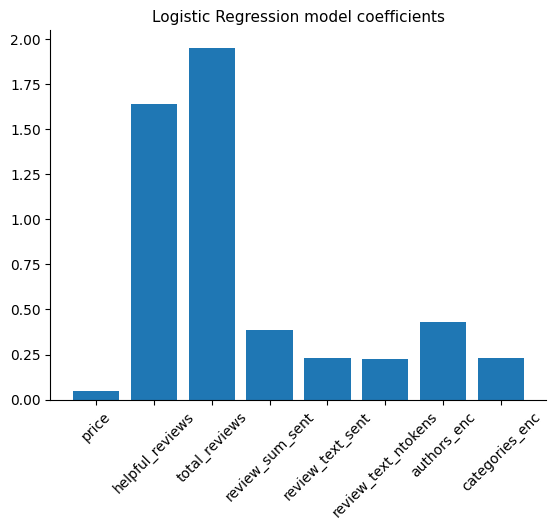
Conclusion#
The total number of reviews and the number of helpful reviews appear to be the most predictive features in this project. This aligns with the minimal impact that various processing methods applied to the categorical variables have had.